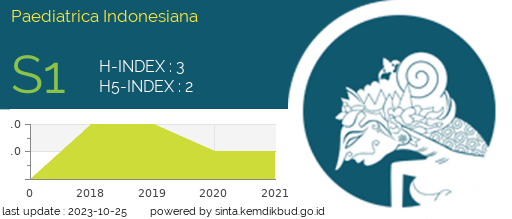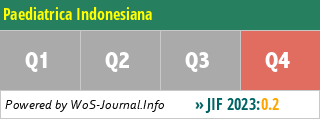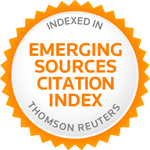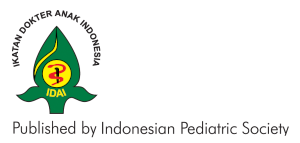Seroepidemiology of Helicobacter pylori in primary school students in Krotek, Cibeber Village, Serang District, Banten, Indonesia
Abstract
Background Helicobacter pylori infection is a common infection.Risk of infection in rural areas is six times higher than in urban
areas.
Objectives To study the prevalence of H. pylori infection in primary school students in rural area and its contributing factors.
Methods A cross-sectional study was performed in a rural primary
school in Serang district, Banten, West Java. Serology of H. pylori
was tested using Bio M pylori kit (Mataram, Indonesia).
Results Forty two of 125 subjects (33.6%) had positive H. pylori
serologies. Bivariate analysis found that the the family habit of
eating together from one container increased the infection risk
5.93 times (95% Cl 3.07 to 11.43). Source of drinking water
from common river increased the risk 9.88 times (95% CI 3.03
to 32.24). Bed and bedroom sharing increased the risk 1.55 times (95% CI 1.23 to 1.95) and 2.22 times (95% CI 1.65 to 2.99), respectively. Multivariate logistic regression analysis including all variables with P <0.25 showed that the most significant factor contributing to H. pylori infection is common river as family drinking water source (OR 24.97, 95% CI 3.9 to 159.76), followed by family habit of eating together from one container (OR 10.23, 95% CI 3.05 to 34.27), and bed or bedroom sharing (OR 9.48, 95% CI 2.4 7 to 36.38).
Conclusion Prevalence of H. pylori infection in rural school
students is 33.6%. There are significant associations between
H. pylori infection and family habit of eating together from one
container, bed sharing with other family members, and family
drinking water source from common river.
References
Blackwell Healthcare Communication, 1996; p. 55-60.
2. Elitsur Y, Short JP, Neace BS. Prevalence of Helicobacter
pylori infection in children from urban and rural West
Virginia. Digest Dis Sci. 1998;43:773-8.
3. Clemens J, Albert J, Rao M. Sociodemographic, hygienic
and nutritional correlates of Helicobacter pylori infection
of young Bangladeshi children. Pediatr Infect Dis J.
1996;15:1113-8.
4. Stone MA. Transmission of Helicobacter pylori. Postgrad
Med ]. 1999;75: 198-200.
5. Selimoglu MA, Ertekin V, Inandi T. Seroepidemiology of
Helicobacter pylori in children living in eastern Turkey.
Pediatr Int. 2002;44:666-9.
6. Rothenbacher D, Bode G, Berg G. Helicobacter pylori among
preschool children and their parents: evidence of parent-child
transmission. J Infect Dis. 1999;179:398-402.
7. Windsor HM, Abioye-Kuteyi EA, Leher JM, Morrow SO,
Bulsara MK, Marshall BJ. Prevalence of Helicobacter
pylori in indigenous western Australians:comparison
between urban and remote rural populations. Med J Aust.
2005;182:210-3.
8. Kelly SM, Pitcher MCL, Farmery SM, Gibson GR.
Isolation of Helicobacter pylori from faeces of patient
with dyspepsia in the United Kingdom. Gastroenterol.
1994; 107: 1671-4.
9. Hegar B, Magdalena, Firmansyah A, Boediarso A, Yuwono
V. Infeksi Helicobacter pylori pada murid sekolah dasar di
Jakarta. Med J Indones. 1998;48:209-12.
10. Lin DB, Nieh WT, Wang HM, Hsiao MW, Ling UP, Changlai
SP, et al. Seroepidemiology of Helicobacter pylori infection
among preschool children in Taiwan. Am J Trap Med Hyg.
1999;61:554-8.
11. Quinonez JM, Chew F, Torres 0, Begue RE. Nutritional
Status of Helicobacter pylori - Infected Children in
Guatemala As Compared With Uninfected Peers. Am J Trop
Med Hyg. 1999;61:395-8.
12. Camargo MC, Yepez MC, Ceron C, Guerrero N, Bravo LE,
Correa P, et al. Age at acquisition of Helicobacter pylori
infection: comparison of two areas with contrasting risk of
gastric cancer. Am J Trop Med Hyg. 2004;9:262-70.
13. Farrell S, Doherty G, Milliken I, Shield M, McCallion W.
Risk factors for Helicobacter pylori infection in children: an
examination of the role played by intrafamilial bed sharing.
Pediatr Int. 2005;24: 149-52.
14. McCallion WA, Murray LJ, Bailie AG, Dalzell AM, O'Reilly
DPJ, Bamford KB. Helicobacter pylori infection in children:
relation with current household living condition. Gut.
1996;39: 18-21.
15. Rothenbacher D, Winkler M, Gonser T, Adler G, Brenner H.
Role of infected parents in transmission ofHelicobacter pylori
to their children. Pediatr Infect Dis J. 2002;21:674-9.
16. Nizam D. Nilai diagnosis uji serologi infeksi Helicobacter
pylori dengan BM tes kualitatif dan kuantitatif pada dyspepsia
ono-ulkus di poliklinik gastroenterologi penyakit dalam
RSCM [Thesis]. Jakarta: University of Indonesia; 1997.
17. Chen MH, Lien CH, Wang W, Wu CL. Helicobacter
pylori infection in recurrent abdominal pain in children--a
prospective study. Acta Pediatr Taiwan. 2001;42:278-81.
18. Das BK, Kakkar S, Dixit VK, Kumar M, Nath G, Mishra OP.
Helicobacter pylori infection and recurrent abdominal pain
in children. J Trop Pediatr. 2003;49:250-2.
19. Nurgalieva ZZ, Malaty HM, Graham DY, Almuchambetova
R, Machmudova A, Kapsultanova D, et al. Helicobacter
pylori infection in Kazakhstan: effect of water source and
household hygiene. Am J Trop Med Hyg. 2002;67:201-6.
Authors who publish with this journal agree to the following terms:
Authors retain copyright and grant the journal right of first publication with the work simultaneously licensed under a Creative Commons Attribution License that allows others to share the work with an acknowledgement of the work's authorship and initial publication in this journal.
Authors are able to enter into separate, additional contractual arrangements for the non-exclusive distribution of the journal's published version of the work (e.g., post it to an institutional repository or publish it in a book), with an acknowledgement of its initial publication in this journal.
Accepted 2016-09-11
Published 2009-10-31












